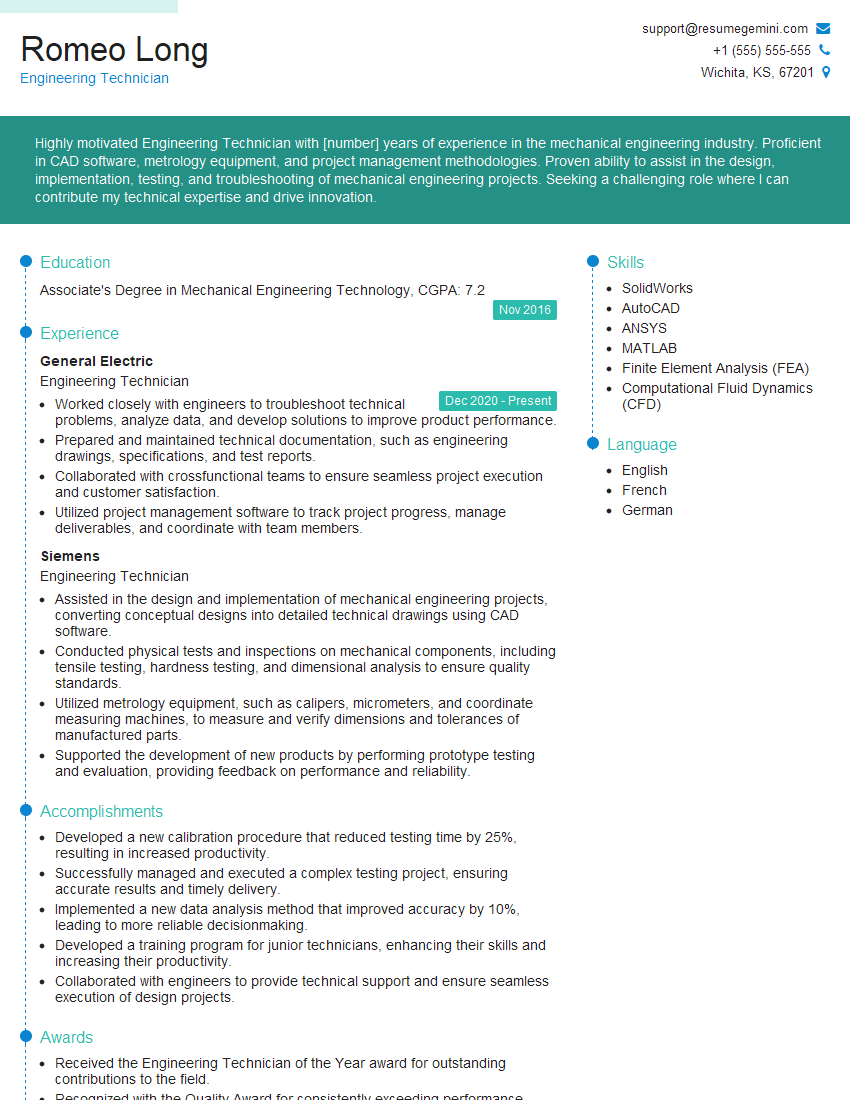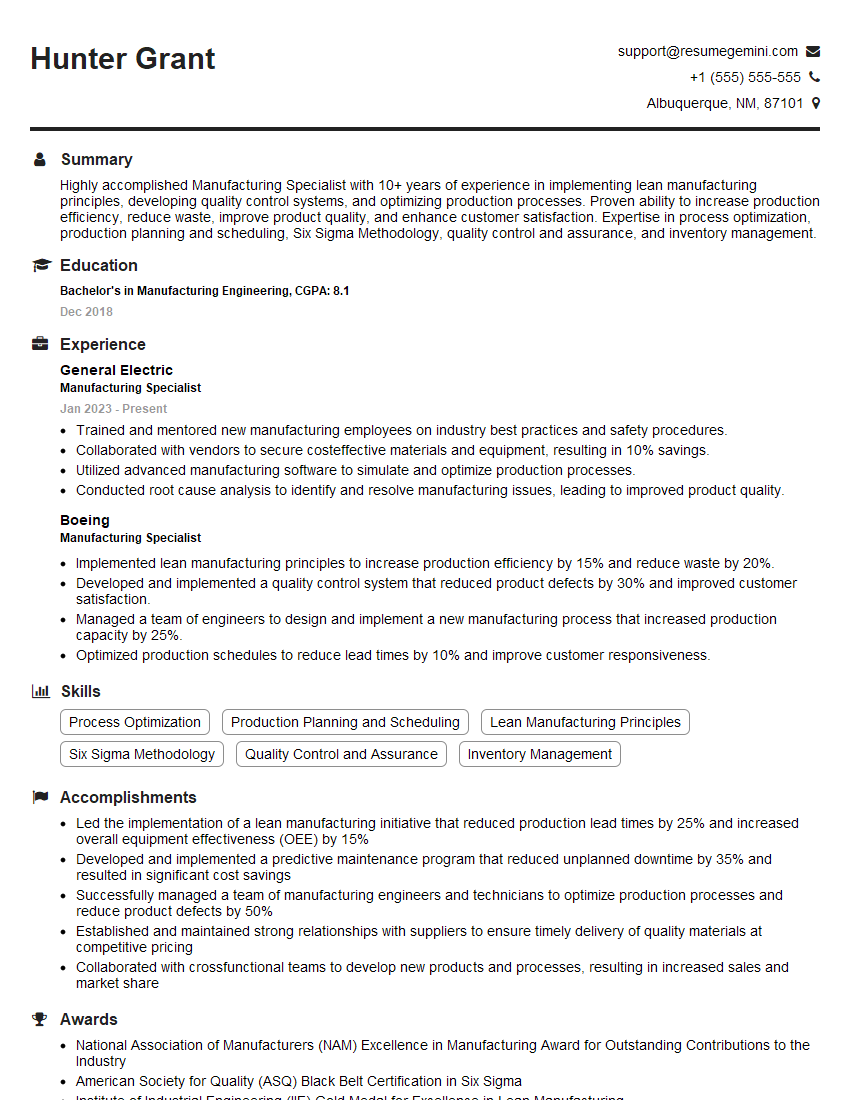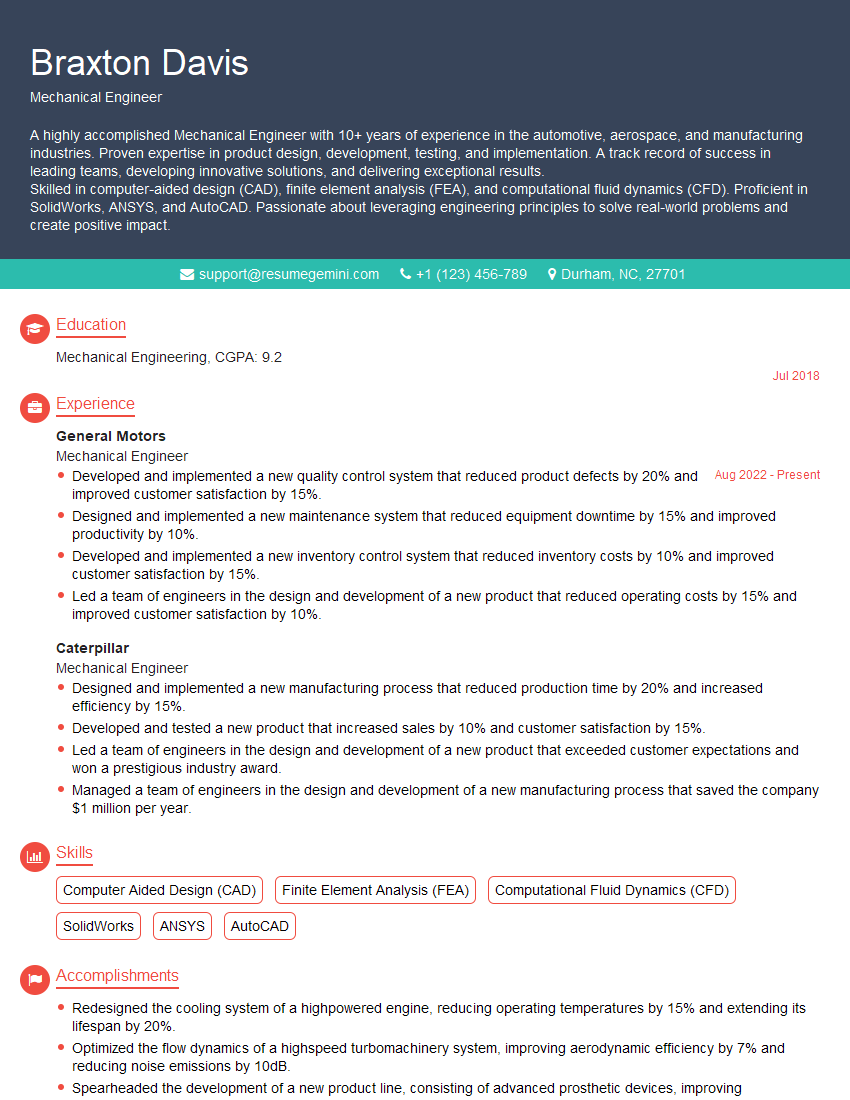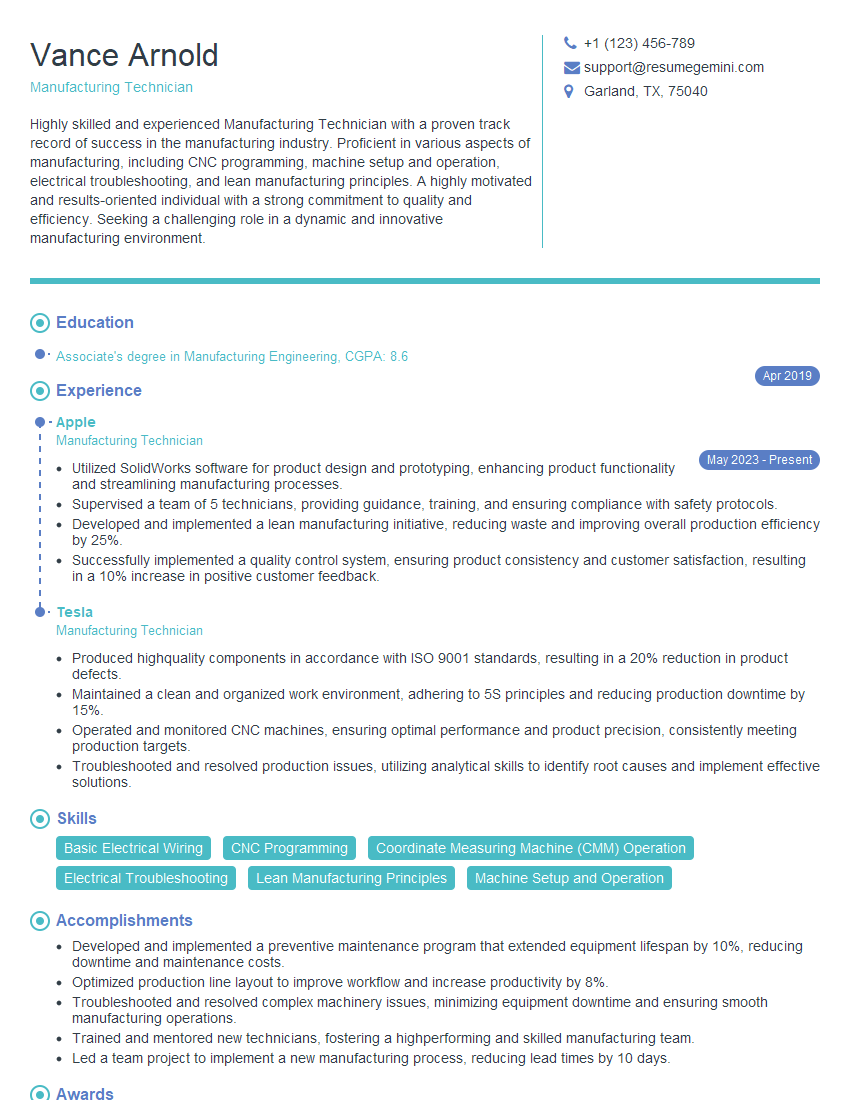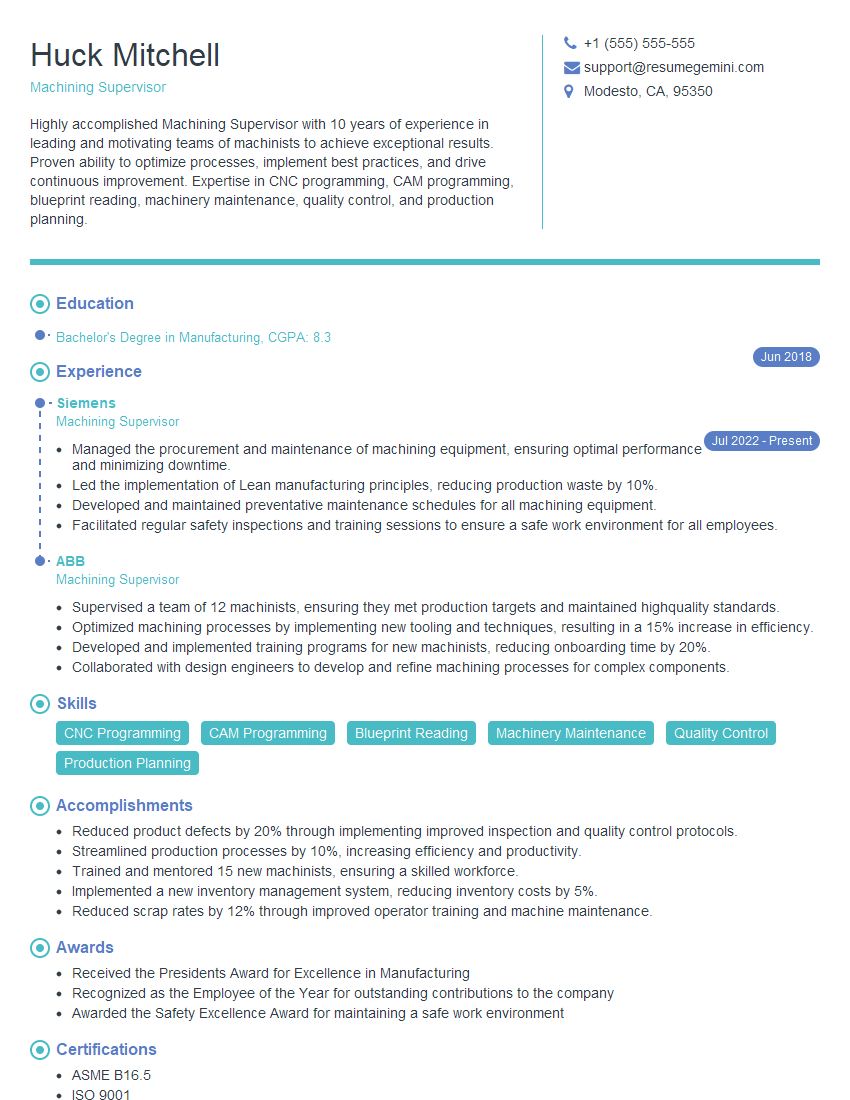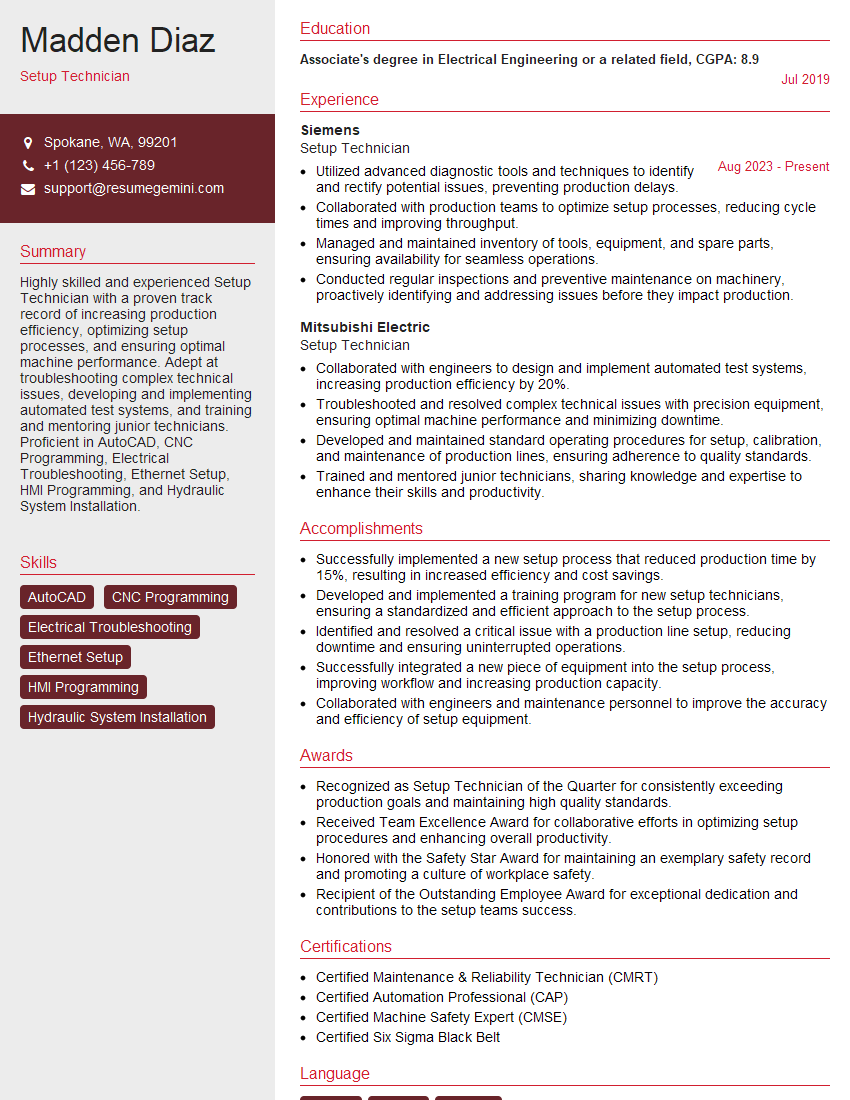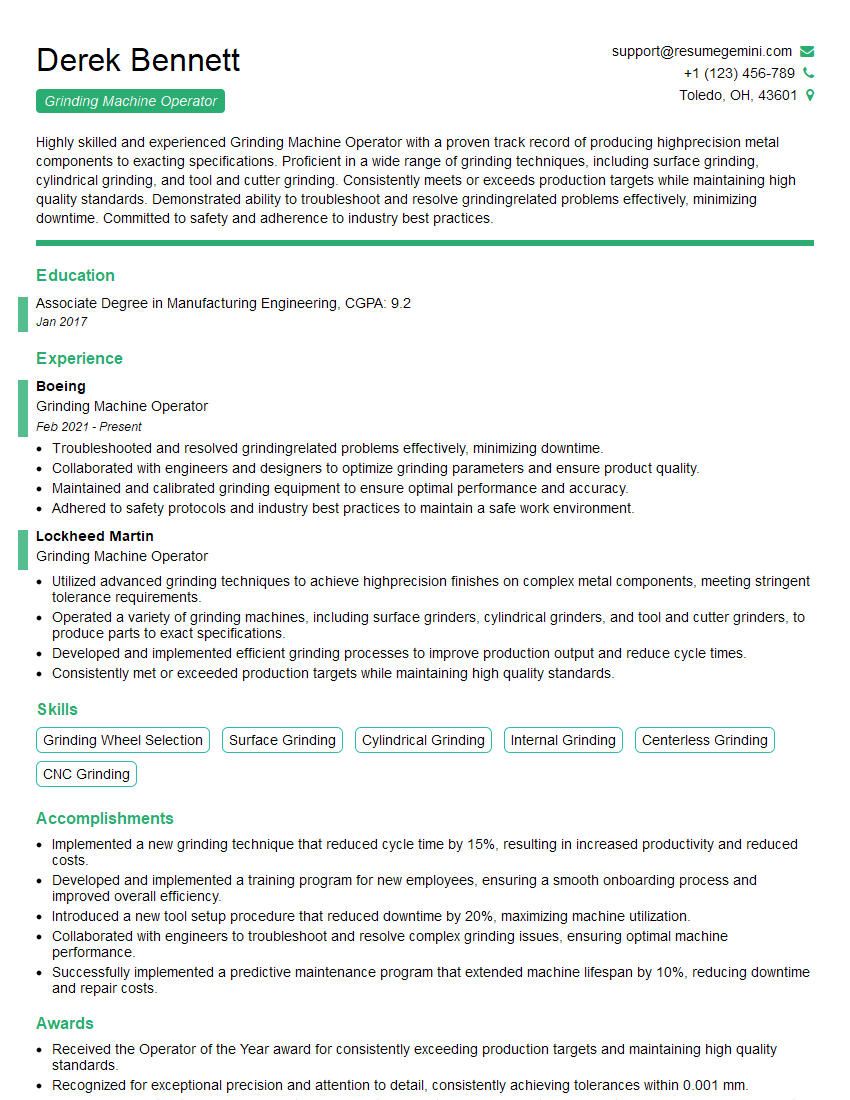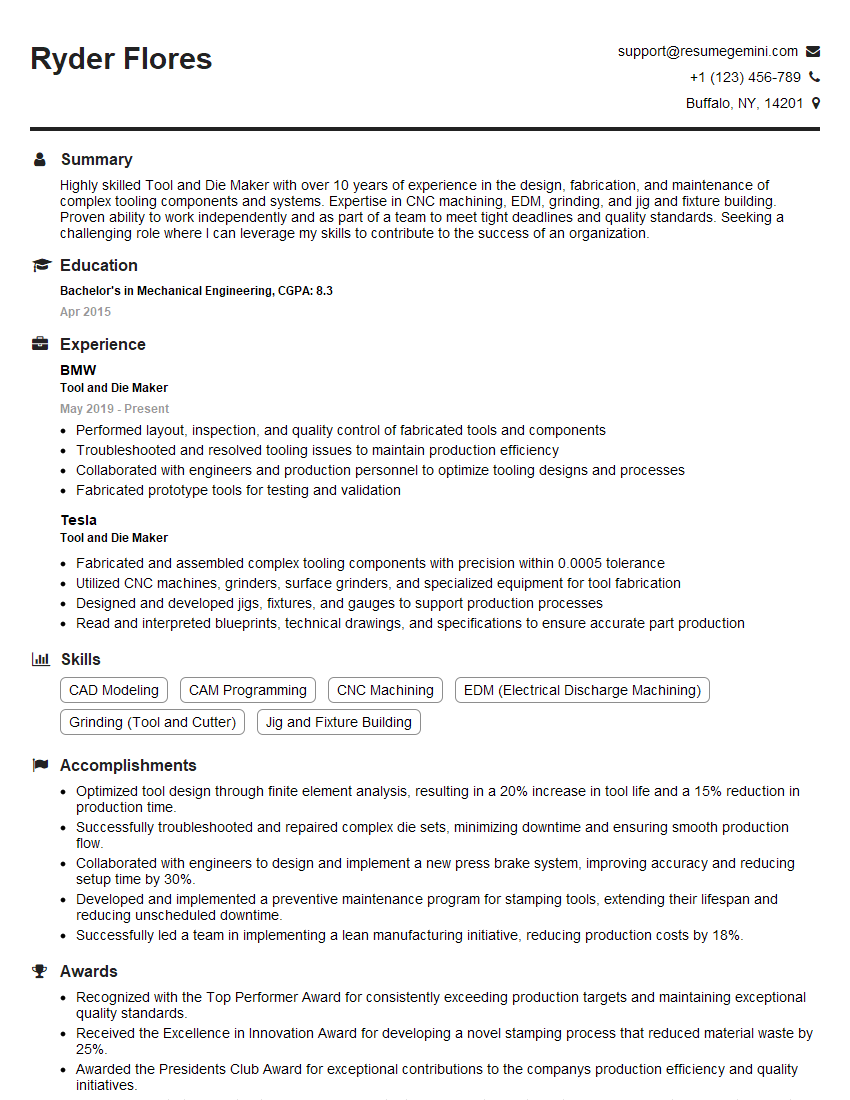The right preparation can turn an interview into an opportunity to showcase your expertise. This guide to Differential feed adjustment interview questions is your ultimate resource, providing key insights and tips to help you ace your responses and stand out as a top candidate.
Questions Asked in Differential feed adjustment Interview
Q 1. Explain the concept of differential feed adjustment in CNC machining.
Differential feed adjustment in CNC machining refers to the ability to vary the feed rate of a cutting tool along different axes independently. Instead of a uniform feed rate across all axes, differential feed allows for programmed adjustments, resulting in different cutting speeds along, say, the X and Y axes during a single operation. Imagine a sculptor carving a complex shape – they don’t move their chisel at the same speed across the entire surface; they adjust their speed and pressure depending on the detail they’re working on. Differential feed in CNC mirrors this precision control.
Q 2. What are the benefits of using differential feed adjustment?
The benefits of differential feed adjustment are numerous. Primarily, it boosts machining efficiency and quality. By adjusting the feed rate along different axes, you can optimize the cutting process for specific parts of the workpiece.
- Improved surface finish: Slower feed rates in critical areas can produce a smoother finish.
- Reduced machining time: Higher feed rates in less critical areas speed up the overall process.
- Enhanced tool life: Carefully controlled feed rates can minimize stress on the cutting tool, extending its life.
- Better control over chip formation: Adjusting feed rates can influence chip size and shape, avoiding problems like chip clogging.
- Greater flexibility in complex part geometries: Differential feed enables the efficient machining of complex shapes that would be difficult or impossible to machine with a uniform feed rate.
Q 3. Describe the different methods for implementing differential feed adjustment.
Differential feed adjustment can be implemented in several ways, primarily through the CNC machine’s control system.
- G-code programming: This is the most common method. Specific G-codes allow for independent feed rate control along each axis. For instance, you might specify a fast feed rate for a roughing pass along the X-axis and a slower feed for a finishing pass along the Y-axis. This requires a deep understanding of G-code and the specific capabilities of the machine.
- CAM software: Computer-aided manufacturing (CAM) software often provides intuitive interfaces for setting differential feed rates. The software automatically generates the necessary G-code based on the programmed toolpaths and desired feed rates.
- Machine-specific functions: Some CNC machines offer built-in functions or macros to simplify the implementation of differential feed. These functions may involve defining feed rate variations based on specific geometric features or process conditions.
The choice of method depends on the complexity of the part, the level of expertise of the programmer, and the capabilities of the CNC machine and its control system.
Q 4. How does differential feed adjustment affect surface finish?
Differential feed adjustment significantly influences the surface finish. Slower feed rates generally lead to a better surface finish, as there is less material removed per unit of time, resulting in finer cuts and smoother surfaces. Conversely, faster feed rates can create a rougher surface. Consider a scenario where you’re machining a curved surface. A slower feed rate along the curve will provide a smoother finish, whereas a faster feed rate along a flat section may be acceptable and would greatly reduce machining time.
Q 5. How does differential feed adjustment affect machining time?
Differential feed adjustment can both increase and decrease machining time depending on its application. In many cases, using a faster feed rate for less critical areas will significantly reduce the overall machining time. However, the implementation of slower feed rates in critical areas might slightly extend the machining process. The key is optimization. Strategic application of differential feed aims for a net reduction in machining time by balancing speed and quality.
Q 6. How does differential feed adjustment affect tool wear?
Differential feed adjustment directly impacts tool wear. By reducing the feed rate in critical areas, you reduce the cutting forces on the tool, extending its life. However, excessive use of high feed rates, especially on hard materials, can lead to accelerated tool wear. The goal is to find a balance that maximizes productivity while minimizing tool wear. Careful consideration of material properties, tool geometry and cutting conditions is crucial in determining an optimal differential feed strategy to prolong tool life.
Q 7. Explain how to calculate the appropriate differential feed rate for a specific machining operation.
Calculating the appropriate differential feed rate involves considering several factors: material properties (hardness, machinability), tool geometry (diameter, number of flutes), desired surface finish, and available machine power. There isn’t a single formula; it’s an iterative process often guided by experience and machining handbooks.
A simplified approach might involve starting with a recommended feed rate for the material and tool from a machining handbook. Then, adjust the feed rate based on the specific requirements of the machining operation. For example, you might reduce the feed rate by 20% in areas requiring a finer finish or increase it by 30% in areas where a rougher finish is acceptable. This requires careful monitoring and adjustment during the machining process to fine-tune for optimal results. Sophisticated CAM software can automate much of this calculation, but understanding the underlying principles is key to successful implementation.
Q 8. What factors influence the selection of a differential feed rate?
Selecting the appropriate differential feed rate is crucial for efficient and precise machining. Several factors play a vital role in this decision. Think of it like adjusting the pace of a runner – you wouldn’t sprint a marathon, and you wouldn’t jog a 100-meter dash. Similarly, the ideal feed rate depends on the specific job.
- Material Hardness: Harder materials require slower feed rates to prevent tool breakage and ensure a good surface finish. Think of trying to cut through a hard rock versus soft butter – you’d need a different approach for each.
- Tool Geometry: The tool’s design significantly impacts the optimal feed rate. A sharper, more robust tool can handle higher feed rates than a dull or weaker one. It’s like using a sharp knife versus a blunt one – the sharp knife will cut more efficiently.
- Cutting Depth: Deeper cuts generally require slower feed rates to avoid excessive stress on the tool and machine. Imagine digging a deep hole with a shovel – you’d work slower than if you were just scratching the surface.
- Machine Capabilities: The machine’s horsepower and rigidity limit the maximum achievable feed rate. Just like a car has a maximum speed, a CNC machine has limitations.
- Desired Surface Finish: A finer surface finish usually necessitates slower feed rates to minimize chatter and imperfections. Think of polishing a piece of jewelry versus roughly shaping a piece of wood.
- Tool Life: Higher feed rates can shorten tool life, leading to more frequent changes and increased costs. It’s a balancing act between speed and longevity.
Q 9. Describe a situation where you had to troubleshoot a problem related to differential feed adjustment.
During a project involving the machining of a complex titanium component, we experienced unexpected chatter during the finishing pass. The component was exhibiting significant surface roughness despite using a fine finishing tool. Initially, the differential feed rate was set too high for the material’s hardness and the complex geometry of the part.
Troubleshooting involved systematically reducing the feed rate in incremental steps. We carefully monitored the surface finish and listened for any chatter. Through this iterative process, we identified the optimal differential feed rate that eliminated the chatter and delivered the desired surface quality. We also optimized the coolant flow to further improve chip evacuation and reduce heat buildup, which also contributed to a successful outcome.
The issue highlighted the importance of carefully considering material properties and geometry when setting differential feed rates, particularly during critical finishing operations.
Q 10. How do you compensate for variations in material hardness using differential feed adjustment?
Compensating for variations in material hardness using differential feed adjustment involves reducing the feed rate proportionally to the increase in hardness. This prevents tool breakage and ensures consistent machining quality. It’s like adjusting your pace when walking uphill – the steeper the incline (harder the material), the slower you go.
This can be done through several methods. A common approach uses a lookup table in the CNC program, mapping specific material hardness values to corresponding feed rates. Alternatively, some CNC systems allow real-time feed adjustment based on sensor data (e.g., cutting force measurements), dynamically adjusting the feed rate to maintain a consistent cutting process.
For instance, if a section of the workpiece is significantly harder than the surrounding material, you would program a slower feed rate for that specific area within your G-code. This ensures the tool doesn’t break while maintaining consistency in the final product.
Q 11. What are the limitations of differential feed adjustment?
Differential feed adjustment, while powerful, isn’t without limitations. The key limitations include:
- Programming Complexity: Implementing differential feed adjustments can add complexity to the CNC program, particularly for intricate parts with many variable material properties.
- Increased Setup Time: Determining appropriate feed rates for various material sections requires careful planning and testing.
- Limited Applicability: Differential feed adjustments might not be suitable for all machining operations, particularly those involving very high-speed cutting or extremely hard materials.
- Machine Limitations: The CNC machine’s control system and servo drives must be capable of supporting the rapid feed rate changes involved in differential feed adjustment.
- Potential for Errors: Improperly programmed differential feed rates can lead to machining errors, tool breakage, or unexpected surface finishes.
Q 12. How does differential feed adjustment interact with other CNC parameters?
Differential feed adjustment significantly interacts with other CNC parameters. A change in feed rate directly affects the cutting forces, which in turn influence spindle speed and power consumption. If not properly managed, this interaction can lead to unwanted tool wear, machine vibrations, and inaccurate machining. Therefore, understanding this interaction is essential for successful application of differential feed.
For example, reducing the feed rate (to account for harder material) might necessitate adjusting the spindle speed to maintain an appropriate cutting speed. If the spindle speed is too low, the cutting process will become inefficient and might result in poor surface finish, and if the speed is too high it may cause excessive tool wear or damage.
Similarly, changes in depth of cut will influence the required feed rate. Deeper cuts generally require slower feed rates. All these factors must be carefully considered in a coordinated approach.
Q 13. Explain the relationship between feed rate, spindle speed, and depth of cut in differential feed adjustment.
In differential feed adjustment, the relationship between feed rate, spindle speed, and depth of cut is interconnected and crucial for optimal machining performance. These parameters are interdependent and need to be balanced. Think of it as a delicate recipe; the correct proportions of each ingredient (parameter) are essential for the final outcome (machined part).
A higher spindle speed (faster rotation of the cutting tool) generally allows for a higher feed rate (faster movement of the tool along the material) for a given depth of cut. However, increasing any of these parameters too much while keeping the others constant can lead to increased cutting forces, resulting in tool wear, surface finish degradation, or even tool breakage. Conversely, decreasing the feed rate would allow for a deeper cut at the same spindle speed but again, a balance needs to be maintained to avoid issues.
The depth of cut directly influences the amount of material removed per pass. A deeper cut will require a slower feed rate to prevent excessive stresses on the tool and the machine. This interrelationship is precisely what differential feed adjustment addresses, allowing for dynamic adjustments based on varying material properties and geometries along the path.
Q 14. How do you program differential feed adjustment using G-code?
G-code offers several ways to program differential feed adjustment. The most common method uses the G92 (local coordinate system) command in conjunction with canned cycles or custom-written subroutines. This allows for specifying different feed rates for specific sections of the part.
A simple example (simplified for illustrative purposes):
G90 G00 X10.0 Y10.0 ;Rapid move to starting point G91 G01 Z-2.0 F50.0 ;Move down 2 mm, feed rate 50 mm/min G91 G01 X5.0 F100.0 ;Move horizontally 5 mm, feed rate 100 mm/min (increased feed) G91 G01 X5.0 F25.0 ;Move horizontally 5 mm, feed rate 25 mm/min (reduced feed for harder section) G91 G01 Z2.0 F50.0 ;Retract the tool
In this code snippet, G91 sets the incremental mode. Notice how the F parameter (feed rate) is changed within the same section of the part, reflecting the adjustment. More complex scenarios involve creating subroutines that dynamically adjust the feed based on sensor feedback or pre-programmed lookup tables, but the core principle remains the same.
Q 15. How do you monitor and control differential feed adjustment during a machining operation?
Monitoring and controlling differential feed adjustment during machining relies heavily on the CNC machine’s capabilities and the specific application. Essentially, we’re adjusting the feed rate independently for each axis, allowing for complex contouring and surface finishes. This is typically monitored through the machine’s control panel, which displays the programmed feed rates for each axis (X, Y, Z, and potentially A and B for rotary axes).
Control is achieved through the CNC program itself. G-code commands allow for precise specification of feed rates, often incorporating variables that dynamically adjust these rates based on programmed conditions or real-time feedback. For example, we might use a canned cycle for a specific operation, or we might write a custom program incorporating conditional statements based on sensor input or tool wear compensation. We would also visually inspect the machined part throughout the operation to ensure it conforms to the design specifications.
Real-time monitoring is often supported via software that displays axis positions, speeds, and other relevant parameters. This allows for immediate detection of discrepancies between the programmed feed and actual machine performance. Any deviation might necessitate immediate intervention, such as adjusting parameters within the program or checking for machine malfunctions.
Career Expert Tips:
- Ace those interviews! Prepare effectively by reviewing the Top 50 Most Common Interview Questions on ResumeGemini.
- Navigate your job search with confidence! Explore a wide range of Career Tips on ResumeGemini. Learn about common challenges and recommendations to overcome them.
- Craft the perfect resume! Master the Art of Resume Writing with ResumeGemini’s guide. Showcase your unique qualifications and achievements effectively.
- Don’t miss out on holiday savings! Build your dream resume with ResumeGemini’s ATS optimized templates.
Q 16. What safety precautions should be taken when using differential feed adjustment?
Safety is paramount when using differential feed adjustment. Because we’re dealing with high-speed, precise movements, a lack of safety precautions can lead to serious accidents.
- Proper machine guarding: All moving parts must be properly guarded to prevent accidental contact. This includes the spindle, chuck, and moving axes.
- Emergency stop readily accessible: The emergency stop button should always be within easy reach.
- Appropriate personal protective equipment (PPE): This includes safety glasses, hearing protection, and appropriate clothing.
- Secure workpiece: The workpiece should be properly clamped and secured to prevent movement during machining. Insufficient clamping is a major cause of accidents in machining.
- Regular machine maintenance: Regular preventative maintenance helps to identify and address potential hazards before they result in accidents.
- Lockout/Tagout procedures: Always follow proper lockout/tagout procedures when performing maintenance or repairs on the machine.
Finally, a thorough understanding of the CNC program and the machine’s capabilities is crucial to prevent unforeseen events and ensure safe operation. Regular training is key to maintain proficiency.
Q 17. How does differential feed adjustment affect the accuracy of the machined part?
Differential feed adjustment significantly affects the accuracy of the machined part, particularly in complex geometries. Precise control over each axis’s feed rate is crucial for achieving the desired surface finish and dimensional tolerances.
Improper adjustment can lead to several issues:
- Dimensional inaccuracies: Inconsistent feed rates can result in parts that are out of tolerance, leading to scrap or rework.
- Poor surface finish: Incorrect feed rates can produce surface imperfections like chatter marks or waviness.
- Tool wear: High feed rates can accelerate tool wear, potentially resulting in premature tool failure or inconsistent machining.
Conversely, precise differential feed allows for:
- High-quality surfaces: A smooth, consistent surface finish can be obtained by precisely controlling the feed rate.
- Accurate geometries: Accurate dimensions and complex shapes can be achieved by controlling the feed rate along different axes.
- Optimized machining time: Careful selection of feed rates can minimize machining time while maintaining accuracy.
Therefore, careful programming and monitoring are essential to guarantee the desired accuracy.
Q 18. How can you optimize differential feed adjustment for specific materials?
Optimizing differential feed adjustment for specific materials requires understanding the material’s machinability characteristics. Different materials respond differently to cutting forces and speeds.
For example, a harder material like hardened steel may require a slower feed rate to prevent tool breakage, while a softer material like aluminum might allow for a higher feed rate to increase productivity. The ideal feed rate is determined through experimentation and established best practices, often documented in machinability data sheets.
Other factors to consider:
- Material hardness: Harder materials generally require slower feed rates.
- Material toughness: Tougher materials may necessitate lower feed rates to avoid excessive tool deflection.
- Tool geometry: The geometry of the cutting tool impacts its ability to remove material effectively at various feed rates.
- Cutting fluid: The use of cutting fluid can significantly influence the optimal feed rate by reducing friction and heat generation.
Often, a trial-and-error approach is used with careful observation of the generated surface finish and tool wear. CNC software frequently supports simulations that can assist in predicting optimal feed rates, but practical testing remains crucial.
Q 19. What are some common problems encountered with differential feed adjustment and how are they resolved?
Common problems with differential feed adjustment include:
- Chatter: Unwanted vibrations during machining, leading to poor surface finish and dimensional inaccuracy. Solution: Reduce feed rate, adjust cutting depth, increase cutting speed, or improve workpiece clamping.
- Tool breakage: Excessive cutting forces or improper feed rate selection can lead to tool failure. Solution: Lower feed rate, use a more robust tool, or adjust cutting parameters.
- Overcutting/Undercutting: The part may be machined with incorrect dimensions due to programming errors or machine inaccuracies. Solution: Verify the CNC program, calibrate the machine, or adjust tool offsets.
- Inconsistent surface finish: Variations in feed rate can produce an inconsistent surface texture. Solution: Optimize feed rate, adjust cutting parameters, and check for machine irregularities.
Troubleshooting often involves careful analysis of the machined part, machine logs, and the CNC program. Systematic investigation, combined with experience, is key to identifying and resolving these issues. A methodical approach to problem-solving, using a checklist and eliminating variables systematically, is highly effective.
Q 20. Describe your experience with different types of CNC machines and their differential feed capabilities.
My experience encompasses a range of CNC machines, including 3-axis milling machines, 5-axis milling centers, and lathe machines. Each machine has its own unique characteristics regarding differential feed capabilities.
For instance, 3-axis machines offer basic differential feed control, primarily allowing independent adjustment of the X, Y, and Z axes. More advanced machines, such as 5-axis milling centers, allow for significantly more complex control, independently manipulating rotary axes (A and B) in addition to the linear axes. This allows for intricate, multi-directional machining operations.
Lathes typically offer differential feed control between the X and Z axes. This allows for different feed rates during turning, facing, and threading operations.
I’ve worked with various CNC controllers, each having its own methods for programming and controlling differential feed rates. This involves familiarity with different G-code commands and control software functionalities. My practical experience enables me to swiftly adapt to diverse machine types and control systems, ensuring optimal performance and precision.
Q 21. Compare and contrast different methods of implementing differential feed adjustment.
Differential feed adjustment can be implemented through several methods:
- G-code programming: The most common method involves using G-code commands within the CNC program to specify feed rates for each axis independently. This offers precise control but requires programming expertise. Example:
G01 X10.0 Y5.0 F100 ; Linear interpolation with X-axis feed at 100 mm/min and Y-axis feed at 100 mm/min - Canneded cycles: Many CNC machines offer canned cycles for common operations (e.g., drilling, milling) that automatically adjust feed rates based on pre-defined parameters. This simplifies programming but offers less flexibility.
- Real-time control: Advanced CNC systems allow for real-time adjustment of feed rates based on sensor feedback or other dynamic conditions. This might involve using programmable logic controllers (PLCs) to modify feed rates dynamically during operation, providing enhanced adaptability and optimization for real-time adjustments to the machining process.
Comparison: G-code offers maximum flexibility and precision but requires more programming skills. Canned cycles are easier to use but less flexible. Real-time control provides dynamic optimization, but requires advanced hardware and software integration.
The best method depends on the complexity of the operation, the machine capabilities, and the programmer’s expertise. Often, a combination of these methods is employed to achieve optimal results.
Q 22. How do you determine the optimal feed rate for various cutting tools?
Determining the optimal feed rate for various cutting tools involves a multifaceted approach, considering several crucial factors. It’s not a single formula but rather a process of balancing cutting tool capabilities, material properties, and desired surface finish. We begin by consulting the tool manufacturer’s recommendations, which provide a starting point based on the tool’s material, geometry, and coatings. These recommendations often specify a range of suitable feed rates for different materials. However, these are guidelines, and real-world conditions necessitate adjustments.
Next, we consider the material being machined. Harder materials require slower feed rates to prevent tool breakage and excessive wear, while softer materials allow for higher feed rates. The desired surface finish also plays a vital role. A finer finish demands a slower feed rate, whereas a coarser finish can tolerate a faster rate. Finally, machine capabilities are also critical. The machine’s horsepower, rigidity, and spindle speed limitations all restrict the maximum achievable feed rate.
Often, we employ a trial-and-error approach, starting with a conservative feed rate from the manufacturer’s recommendations and gradually increasing it until we observe signs of tool wear, chatter, or unsatisfactory surface finish. Monitoring parameters such as cutting forces, vibrations, and temperatures helps prevent tool damage and ensures the process remains stable. The process is iterative, fine-tuning the feed rate to achieve the optimal balance between productivity and quality.
For example, machining a hardened steel component might begin with a feed rate at the lower end of the manufacturer’s range, whereas machining aluminum might allow for a considerably higher feed rate. Data logging and analysis from these trials are crucial to optimizing future jobs with similar materials and tools.
Q 23. How does workholding affect the effectiveness of differential feed adjustment?
Workholding significantly impacts the effectiveness of differential feed adjustment. A rigid and stable workholding setup is paramount for accurate and consistent results. Any deflection or vibration in the workpiece caused by inadequate clamping will directly affect the accuracy of the differential feed adjustments, leading to inconsistent cuts and potentially damaging the tool or workpiece. Think of it like trying to draw a straight line with a wobbly ruler – the result won’t be precise.
For instance, if a component is poorly clamped, even slight variations in the cutting forces during differential feed adjustment can cause the workpiece to shift or flex. This leads to inaccuracies in the final dimensions and a poor surface finish. Strong clamping, choosing appropriate fixtures, and ensuring proper alignment are critical. Using specialized fixtures that minimize deflection or vibration, such as hydraulic or pneumatic chucks, can enhance workholding and the effectiveness of differential feed significantly. Regular inspection of the workholding setup before and during the machining process ensures that the clamps remain securely tightened and the workpiece is accurately positioned.
Q 24. Describe your experience with using software to simulate and optimize differential feed adjustment strategies.
I have extensive experience using CAM software to simulate and optimize differential feed adjustment strategies. Software like Mastercam or FeatureCAM allows us to program complex toolpaths with varying feed rates based on specific geometric features or material properties. This is significantly more efficient and precise than manual programming. Before cutting a workpiece, we simulate the machining process in the software to virtually verify the toolpaths, feed rates, and cutting conditions. This allows us to identify and rectify potential issues like collisions or excessive tool wear before they occur in the actual machining process, saving time and resources.
For example, in a recent project involving the machining of a complex impeller blade, the software allowed me to simulate different differential feed strategies. By varying the feed rate in different sections of the blade, based on the geometry and material thickness, I was able to optimize the cutting process, reduce machining time by 15%, and improve the surface finish. The software also provides valuable data, such as cutting forces and tool wear predictions, which guide further optimization. The ability to visualize and analyze the simulated results is invaluable for fine-tuning the differential feed adjustments and ensuring a successful machining operation. This prevents costly errors on expensive components.
Q 25. What are the advantages and disadvantages of using canned cycles versus manual programming for differential feed adjustment?
Canned cycles and manual programming both offer methods for differential feed adjustment, each with its own set of advantages and disadvantages. Canned cycles, pre-programmed routines for common machining operations, provide a quick and efficient way to implement basic differential feed strategies, especially for repetitive tasks. They’re user-friendly and require less programming expertise, making them suitable for less complex parts.
However, their flexibility is limited. Complex geometries or specific material requirements might not be easily accommodated by canned cycles. Manual programming, on the other hand, offers far greater control and flexibility. It allows for precise control over feed rates at every point in the toolpath, enabling complex differential feed adjustments tailored to intricate shapes and material properties. This precision is crucial for high-quality surface finish and dimensional accuracy in intricate components.
The disadvantage of manual programming is the increased time investment and higher level of programming expertise required. There is a greater chance of programming errors if not done carefully. The choice between canned cycles and manual programming often depends on the complexity of the part, the desired level of control, and the programmer’s skills. For simple parts, canned cycles are efficient. For complex parts demanding high precision, manual programming is necessary.
Q 26. How do you troubleshoot issues with inconsistent surface finish caused by differential feed adjustment?
Troubleshooting inconsistent surface finishes caused by differential feed adjustment often involves a systematic approach. The first step is to carefully examine the surface finish itself. Are the inconsistencies localized to specific areas? Are there patterns to the imperfections? This visual inspection gives clues to the underlying cause. For instance, regular chatter marks often indicate instability in the cutting process.
Next, we investigate the toolpath and the differential feed rate programming. We look for abrupt changes in feed rate or areas where the feed rate might be too high for the specific geometry or material. Tool wear is another crucial aspect to check. Worn or damaged tools can directly contribute to inconsistent surface finish. The machine’s condition, such as worn bearings or improper spindle alignment, can also influence surface quality.
The troubleshooting process involves adjusting the feed rates in problematic areas, changing the cutting tool, verifying toolpath accuracy, and ensuring machine rigidity. Sometimes, a combination of factors contributes to the problem. Careful documentation and analysis of the machining parameters help isolate the root cause. Data logging of spindle speed, feed rate, and cutting forces can be invaluable in identifying patterns and improving future processes. It is an iterative process. Sometimes, adjusting the workholding improves the situation significantly.
Q 27. Describe a time you had to adjust the differential feed rate on the fly due to unexpected conditions.
During a high-precision milling operation on a titanium alloy component, we encountered unexpected material hardness variations. The initially programmed differential feed rate, optimized for the assumed material properties, proved insufficient for certain areas. The tool was exhibiting signs of excessive wear and the surface finish was deteriorating.
Immediately, I made the decision to reduce the feed rate on the fly using the machine’s manual override function, prioritizing tool life and surface quality. The machine’s control system allowed for real-time adjustments. I carefully monitored the cutting parameters while slowly reducing the feed rate in the affected areas until the tool wear and surface finish improved. This required quick thinking and experience to assess the situation and make informed adjustments. After the operation, a detailed analysis determined the hardness variation, and the program was adjusted to reflect the actual material characteristics for future production runs.
This experience highlighted the importance of real-time monitoring and the ability to adapt to unforeseen circumstances, preventing potential damage to the expensive workpiece and maximizing the success of the operation.
Q 28. How do you document and maintain records related to differential feed adjustment?
Documentation and maintenance of records related to differential feed adjustment are critical for repeatability, process improvement, and troubleshooting. We maintain detailed records in our database system. This includes the part drawing, material specifications, tool selection, programmed toolpaths, and the actual feed rates utilized during machining. We also document any adjustments made during the process, the rationale behind them, and any observed issues.
The database contains detailed logs of all cutting parameters, including spindle speed, feed rate, depth of cut, and cutting forces. This information is invaluable for analyzing process performance, identifying areas for improvement, and troubleshooting future problems. We also keep a comprehensive library of tool life data, associating specific tools with their usage history and performance. This data helps us optimize tool selection and predict when tool changes are needed.
Additionally, we regularly back up the database and ensure the data is readily accessible to authorized personnel. This robust documentation system guarantees consistent machining results, supports process improvement initiatives, and provides the essential information needed for efficient troubleshooting and ongoing optimization.
Key Topics to Learn for Differential Feed Adjustment Interview
- Understanding the Fundamentals: Grasp the core principles behind differential feed adjustment, including its purpose and the different types of systems used.
- Mathematical Models and Calculations: Become proficient in the mathematical calculations and models used to determine optimal feed rates and adjustments. Practice applying these models to various scenarios.
- Practical Applications and Case Studies: Explore real-world applications of differential feed adjustment across different industries and manufacturing processes. Analyze successful and unsuccessful case studies to understand the nuances.
- Troubleshooting and Diagnostics: Develop a strong understanding of common problems encountered during differential feed adjustment and learn effective troubleshooting techniques. Practice identifying and resolving issues.
- Sensor Technology and Data Acquisition: Familiarize yourself with the different sensor technologies used to monitor and control feed rates, as well as data acquisition methods and their interpretation.
- Advanced Techniques and Optimization: Explore advanced techniques for optimizing differential feed adjustment, such as adaptive control strategies and predictive modeling.
- Safety Considerations and Best Practices: Understand the safety protocols and best practices associated with differential feed adjustment to ensure safe and efficient operation.
Next Steps
Mastering differential feed adjustment significantly enhances your skillset and opens doors to exciting career opportunities in advanced manufacturing and automation. To maximize your job prospects, focus on crafting an ATS-friendly resume that highlights your expertise. ResumeGemini is a trusted resource to help you build a professional and impactful resume that effectively showcases your skills and experience. We provide examples of resumes tailored to differential feed adjustment to guide you in creating a compelling application. Take the next step towards your dream career today!
Explore more articles
Users Rating of Our Blogs
Share Your Experience
We value your feedback! Please rate our content and share your thoughts (optional).
What Readers Say About Our Blog
Hello,
We found issues with your domain’s email setup that may be sending your messages to spam or blocking them completely. InboxShield Mini shows you how to fix it in minutes — no tech skills required.
Scan your domain now for details: https://inboxshield-mini.com/
— Adam @ InboxShield Mini
Reply STOP to unsubscribe
Hi, are you owner of interviewgemini.com? What if I told you I could help you find extra time in your schedule, reconnect with leads you didn’t even realize you missed, and bring in more “I want to work with you” conversations, without increasing your ad spend or hiring a full-time employee?
All with a flexible, budget-friendly service that could easily pay for itself. Sounds good?
Would it be nice to jump on a quick 10-minute call so I can show you exactly how we make this work?
Best,
Hapei
Marketing Director
Hey, I know you’re the owner of interviewgemini.com. I’ll be quick.
Fundraising for your business is tough and time-consuming. We make it easier by guaranteeing two private investor meetings each month, for six months. No demos, no pitch events – just direct introductions to active investors matched to your startup.
If youR17;re raising, this could help you build real momentum. Want me to send more info?
Hi, I represent an SEO company that specialises in getting you AI citations and higher rankings on Google. I’d like to offer you a 100% free SEO audit for your website. Would you be interested?
Hi, I represent an SEO company that specialises in getting you AI citations and higher rankings on Google. I’d like to offer you a 100% free SEO audit for your website. Would you be interested?
good





